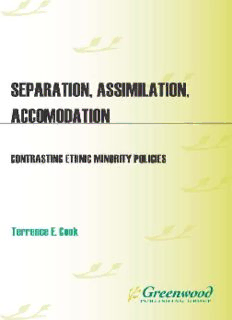
Separation, Assimilation, or Accommodation: Contrasting Ethnic Minority Policies PDF
Preview Separation, Assimilation, or Accommodation: Contrasting Ethnic Minority Policies
Separation, Assimilation, or Accommodation C E M ONTRASTING THNIC INORITY P OLICIES Terrence E. Cook LibraryofCongressCataloging-in-PublicationData Cook,Terrence,E.,1942– Separation,assimilation,oraccommodation:contrastingethnicminoritypolicies/Terrence E.Cook. p. cm. Includesbibliographicalreferencesandindex. ISBN0–275–97825–7(alk.paper) 1.Ethnicity—Politicalaspects. 2.Ethnicconflict. 3.Assimilation(Sociology) I.Title. GN495.6.C69 2003 305.8—dc21 2002033384 BritishLibraryCataloguinginPublicationDataisavailable. Copyright(cid:1)2003byTerrenceE.Cook Allrightsreserved.Noportionofthisbookmaybe reproduced,byanyprocessortechnique,withoutthe expresswrittenconsentofthepublisher. LibraryofCongressCatalogCardNumber:2002033384 ISBN:0–275–97825–7 Firstpublishedin2003 PraegerPublishers,88PostRoadWest,Westport,CT06881 AnimprintofGreenwoodPublishingGroup,Inc. www.praeger.com PrintedintheUnitedStatesofAmerica Thepaperusedinthisbookcomplieswiththe PermanentPaperStandardissuedbytheNational InformationStandardsOrganization(Z39.48–1984). 10 9 8 7 6 5 4 3 2 1 Contents Figures vii Introduction ix Chapter1 SeparationsasSegregations:Strategiesofthe StrongerEthnicGroup 1 Chapter2 SeparationsasSeparatisms:StrategiesoftheWeaker EthnicGroup 21 Chapter3 AssimilationsasControls:StrategiesoftheStronger EthnicGroup 61 Chapter4 AssimilationsasIntegrations:Strategiesofthe WeakerEthnicGroup 89 Chapter5 AccommodationsasMinimal:Strategiesofthe StrongerEthnicGroup 105 Chapter6 AccommodationsasMaximal:Strategiesofthe WeakerEthnicGroup 121 Chapter7 HowtoGetOutofaZero-sumGame:TheCaseof theKashmirConflict 147 Chapter8 TransformationalGameTheoryinConflict Resolution 165 References 179 Index 191 Figures 1.1 SixMainDirectionsinEthnicMinorityPolicy 3 5.1 PairedEthnicMinorityPolicyChoicesandPossible Consequences 107 5.2 HowRegimeandPartyVariablesAffectChancesofEthnic Accommodation 111 6.1 HowStrongerandWeakerEthnicGroupsApproach Accommodations 134 6.2 SpansofCoalitions,LeadershipMedians,and AccommodationDistancesbetweenGroupsinConflict 145 7.1 TypeofGamesorProblemSituations:OrderedbyTypically IncreasingDanger 149 8.1 FourTypesofGameTheory 168 8.2 EvolutionaryGameTheoryContrastedwithTransgenic GameTheory 170 8.3 TransformingGames,Benevolentvs.MalevolentDirections 172 8.4 FourWaysThirdPartiesMayHelpTransformaHigh- ConflictGameintoaMoreTractableSituation 176 Introduction Thisisabookaboutconflictsofethnicgroups,defining“ethnic”quitebroadly to understand racial, religious, linguistic, national, or kindred cultural cate- goriesotherthanthoseofclass.Byonedefinition,anethnicgroupsharesits name,notion of common descent, history,culturaltraits,andsenseofhome place(cf.Gurr,2000,5;Smith,1986,22–28).AlthoughIdwellonethnicities, othersmayfindthatthebook’sanalysiscanbereadilyextendedtootherkinds ofconflicts,suchasthoseofclassorgender. Ethnic conflicts, often far more than other sorts of human conflicts, are prominent in everyday news, if only because they often result in highly de- structiveforms,takingmanyhumanlivesaswellasdestroyingmuchproperty. International wars have been sparse since 1990, whereas civil warring has become common, although the violence has somewhat subsided fromabout 1995. But Maya Chadda notes that “of the eighty-six conflicts recorded by theUnitedNationssince1989,onlythreeinvolvedarmedconflictsbetween countries. The rest were internal wars caused by ethnic and intercommunal violence”(Chadda,1997,x–xi).MettaSpenceroffersareinforcingobservation of one year: worldwide, of the 40 wars fought in 1996, 38 of them involved conflictbetweenrivalethnicgroups,andoneofthetworemainingwasawar amongdistinctiveclansofwhatwasessentiallythesameethnicgroupinSo- malia(Spencer,1998,18;also38notes28and29).Butmoreviolenceoccurs inlessspectacularforms,suchasethnicriotsorindividualactsofaggression. Ethnic animosity was involved in the terroristic destruction of the World TradeCentertowersandpartofthePentagon,takingabout3,000lives.Any theoryabouthumanviolencemustgiveacentralplacetoethnicgrouprival- ries. These are humanly caused and potentially subject to human control. x Introduction Although there are many speculative theories of human aggression, we ac- tuallyknowverylittleaboutit,asidefromgoodevidencethathotterclimates, and the hottest seasons of temperate climates,correlatewithmoreofit.But becausewecannotair-conditionmeancitystreets,thatcauseisnotsomething wecancontrol(Geen,2001,32–35). Virtually all states have some ethnic diversity, and many of these states experience heightened forms of conflict among groups. Furthermore, it is impossibleforastatenottohavesomekindofpolicy(orsometimesasetof policies)regardingitsethnicminorities. For the sponsors of a given sort of policy, what are they saying they are trying to do? When can we take these self-reports for granted, and when should we consider the possibility of ulterior motives? What are the implicit assumptions behind those announced and unannounced policy objectives? Whataresometheoreticalandpracticalproblemswiththosepolicyinitiatives, considering such possibilities as counterproductivity, unintended and un- wantedandusuallyunforeseenconsequencesofimplementation,shouldthat succeed? Ifapolicyworksatallathelpingaproblem,perhapsitisappliednotenough whentheproblemisnotbeingbettermanagedorsolved. But a policy approach is being pushed too far when it (1) becomes coun- terproductive with regard to its own goal, or (2) does unacceptable damage to the effort to reach other worthwhile goals. Although one could arguably make an exception for moderation, literal “maximization”ofanyonegoalis madness.Trade-offsituationsinevitablyoccur,butitisrarelyclearhowsuch tensions among worthwhile goals should be handled. Illustrations of such problemswillariseduringthecourseofthisbook. OF HUMAN PSYCHOLOGY: IMMEDIATE, EMERGENT, SUBMERGENT Someholdthatanysocialsciencemustberootedin,orevenquiteliterally reducedto,“microfoundations,”orsomeallegedlysimplepropositionsabout human behavior at the micro (small) level that could permit the building of theoriesatthemeso(middle)ormacro(large)levels. Perhaps this thinking supposes thereare someverysimplemechanismsat thesmalllevelthatcanpermitdeductionofbehavioratmiddleorlargelevels. Theremaybesomeimmediateandsimpleaspectsofhumanpsychology,such as drives for self-preservation or sex, that often are shared with nonhuman animals.Therearealsorelativelysimplemechanismsoflearningorchanging therelationshipofstimuliandresponsesasthroughimitation,classical(Pav- lovian)conditioning,oroperant(Skinnerian)conditioning. But sometimes forms of learning seem less helpful in predicting political behavior than are some cognitive weaknesses that limit our more complex psychology.AsHerbertSimonandhisassociatesknew,weareonly“bound- Introduction xi edly”rationalatbest.Considersomelimitsofourrationality.Wetendtobe unableto(1)discernmanydifferencesinwhatseemsremotefromus,suchas inanideologicalfamilyremovedfromourown,(2)preferenceordertoomany things,(3)evaluatebyverymanystandards,(4)graspmanyoptionsasawhole setratherthan by pairs orserially,meaningonebyone,(5)bemorelogically consistentthanaffectivelysoasinuncriticallylinkingonethingpleasantwith another,orwhatispainfulwithitslike,(6)experienceasmuchpleasureinan equivalentgainaspaininaloss,(7)avoiddiscountingwhatwecouldnotget yesterday or what we could only get in the distant future, (8) recognizethat thesameinputmaynothaveaconstantrelationtooutputatallmagnitudes, places, and times, (9) avoid the gambler’s fallacy of exaggerating the overall probabilityofgaindependentonaseriesofreallydiscreteevents,(10)correctly see much higher risk when a specific case of low risk becomes repeated at manysimilarplacesorduringmanyfutureepisodes,or(11)avoidbeingmired intosunkcosts,orthrowinggoodmoneyafterbad,or(12)recognizethatnot allindividualswillbealikeinalloftheforegoing. Bycontrast,whatwouldunboundedrationalitylooklike?Probablyinspired byalargelyimaginaryviewofinvestorbehavior,manyeconomistswouldhave usspecifyarelevantframeofidentity(self-interestorother-regarding,where many have accented self-interest), a master motive or “maximand” (often taken to be economic gain), and a general model of how agents handle un- certainty(usuallytakentobeexpectedutility-maximizing).Althoughthisra- tionalchoiceparadigmincreasinglypenetratesothersocialsciences,including political science, I am growing quite skeptical of the view that speaks as if salient identity, dominant aim, and orientation toward uncertainty aresome “simples”thatpreexistanysituation. On the contrary, I recognize rather complex human psychological reper- tories in personal identities, goals, and postures toward risk,differentlymo- bilizedinadaptationtothesituationofchoice.Further,withoutmeaningany personification, I hold that the situations of agents often largely determine whatisselectedfromsuchrepertories,orcanliterallyshapetheserepertories, asinaddingorsubtractingmotives,andsoon.Thatis,Irecognizethereality of“emergentproperties”and“submergentproperties,”asdefinednext. First,letusaddressemergentproperties.MarioBunge,althoughconceding that wholes are built up of parts, has denied the position (called “methodo- logical individualism”) that social behavior must be reducible to primitive axiomsandhypothesesofhumanbehavior(letalonetochemistryorphysics), orthatlarge-scalemovementsofmattermustbeaccountedforultimatelyby subatomictheories,perhapsendingwithsuperstringtheory.Whatthemeth- odological individualists fail to grasp is that there are emergent properties in manyphenomena,suchthat,say,ascalingupwillrevealbehavioralproperties that could never be discerned by looking at the parts (in the social sciences, individuals)alone,evenifasystemicanalysiswouldincludeattentiontoparts (Bunge, 1996, 51). He goes on to say, “the individual approach to society
